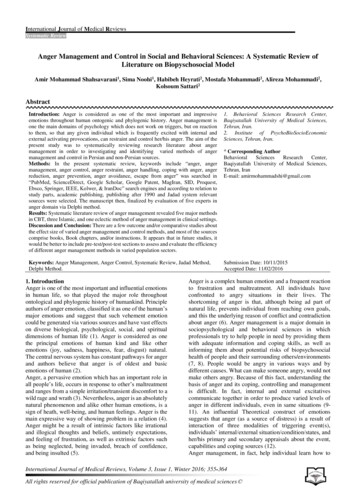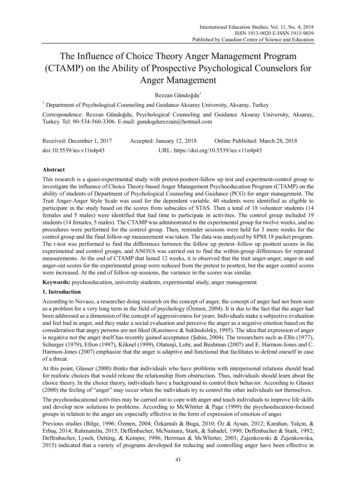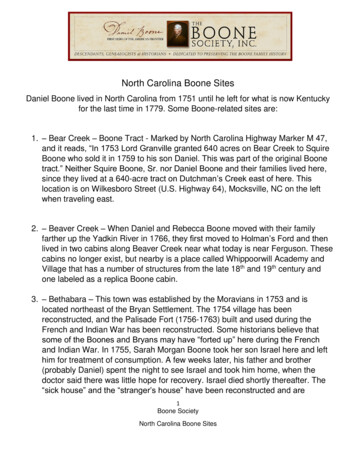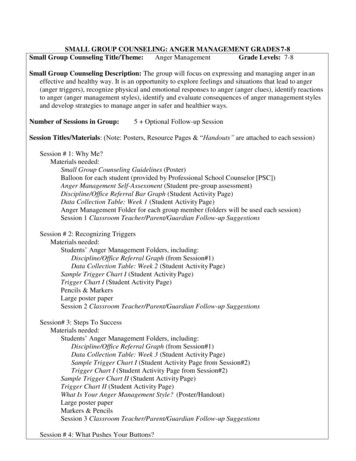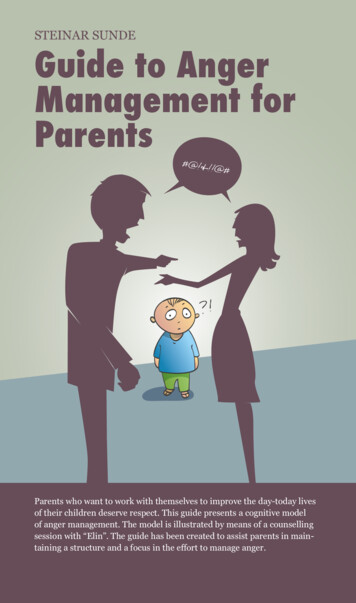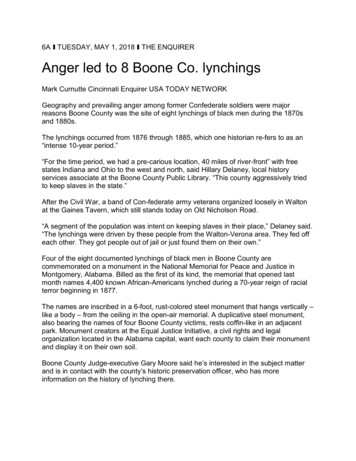
Transcription
6A TUESDAY, MAY 1, 2018 THE ENQUIRERAnger led to 8 Boone Co. lynchingsMark Curnutte Cincinnati Enquirer USA TODAY NETWORKGeography and prevailing anger among former Confederate soldiers were majorreasons Boone County was the site of eight lynchings of black men during the 1870sand 1880s.The lynchings occurred from 1876 through 1885, which one historian re-fers to as an“intense 10-year period.”“For the time period, we had a pre-carious location, 40 miles of river-front” with freestates Indiana and Ohio to the west and north, said Hillary Delaney, local historyservices associate at the Boone County Public Library. “This county aggressively triedto keep slaves in the state.”After the Civil War, a band of Con-federate army veterans organized loosely in Waltonat the Gaines Tavern, which still stands today on Old Nicholson Road.“A segment of the population was intent on keeping slaves in their place,” Delaney said.“The lynchings were driven by these people from the Walton-Verona area. They fed offeach other. They got people out of jail or just found them on their own.”Four of the eight documented lynchings of black men in Boone County arecommemorated on a monument in the National Memorial for Peace and Justice inMontgomery, Alabama. Billed as the first of its kind, the memorial that opened lastmonth names 4,400 known African-Americans lynched during a 70-year reign of racialterror beginning in 1877.The names are inscribed in a 6-foot, rust-colored steel monument that hangs vertically –like a body – from the ceiling in the open-air memorial. A duplicative steel monument,also bearing the names of four Boone County victims, rests coffin-like in an adjacentpark. Monument creators at the Equal Justice Initiative, a civil rights and legalorganization located in the Alabama capital, want each county to claim their monumentand display it on their own soil.Boone County Judge-executive Gary Moore said he’s interested in the subject matterand is in contact with the county’s historic preservation officer, who has moreinformation on the history of lynching there.
Rape of white women was common accusationThe four Boone County victims named in the Alabama memorial are Parker Mayo,Theodore Daniels, Charles Dickenson and Sam Scales.Three of the four, excluding Dickenson, were accused of rape. About 25 percent of the4,400 memorialized African-American lynching victims allegedly committed rape,according to the Equal Justice Initiative’s 2015 “Lynching in America” report.March 1877: Mayo, a native of South Carolina, was accused of trying twice to rape the9-year-old daughter of a white family in the Walton area. The next day, Mayo tried torape the wife of a nearby farmer, The Enquirer reported. Her husband heard herscreams. Mayo was captured and taken to jail in Burlington.The Daily Cincinnati Enquirer published this illustration of the lynching of Henry Corbinin Oxford, Ohio, on the front page of its Jan. 15, 1892, edition.THE CINCINNATI ENQUIRER
The Gaines Tavern in Walton, Ky., is believed by historians to have been a meetingplace of a band of Confederate army veterans.ENQUIRER FILEOn the night of his second attempted rape, The Enquirer reported, Mayo’s body wasfound hanging from a tree in Walton. The Mayo lynching took place near GainesTavern.The tavern had been owned by Archibald Gaines, who died in 1871. Before the CivilWar, he also owned several slaves, including Margaret Garner and her husband,Robert, and their four children. The subject of Toni Morrison’s 1987 novel “Beloved,” theGarners escaped in 1856 into Ohio but were recaptured in Cincinnati by U.S. marshalsaccompanied by Gaines and a posse of men. Robert Garner died in the shootout.Margaret Garner slit the throat of her 2-year-old daughter rather than see her face a lifeof slavery and stabbed herself and her other three children.September 1879: Daniels, whose name was also reported as Theodore Daniels, was afarmhand who worked near Union and had been accused of raping a 16-year-old whitegirl in Walton. The Cincinnati Daily Star reported the girl’s name as Mary Carney. TheBoone County Recorder reported her name as Georgia Billeter, age 15.The Daily Star reported that the rape was “prevented by the timely arrival of friends,who caught the rascal and took him to Burlington, where a posse of citizens was
summoned. That was about 7 o’clock this morning when a mock trial was held and thenegro was sentenced to be shot.”Daniels, who denied the alleged crime, was tied to a tree and shot, the fatal ballsevering the main artery in his neck. The mob then hung him. He bled to death, theDaily Star reported.May 1884: Dickenson was biracial, 17, and worked for a farmer near Walton. InFebruary, he had stolen 192 from the family and went to Louisville, where he enlistedin the U.S. Army. He was captured and returned to Burlington’s jail. He and otherprisoners would escape, but Dickenson was recaptured after several weeks.(His surname was spelled multiple ways in newspaper reports. The Chicago Tribunespelled it Dickerson. The Boone County Recorder reported it as Dickson. The Enquireridentified him as Charles Dickenson.)On Saturday night, May 3, a drunken mob of masked men broke into the jail,overpowered the jailer and took Dickenson to the hangman’s tree just outside of town.The Enquirer re-ported on May 6 that the drunken assailants botched the hanging andde-scribed the irregular knot and how Dickenson’s feet were only a foot off the ground.His body was dug up the next night from his shallow pauper’s grave by local doctorsand medical students and dissected, The Enquirer wrote.September 1885: Scales was a hired farmhand who was accused of raping a 6-yearold white girl, daughter of a family that also worked on the farm near Walton. A wireservice re-port on Sept. 11 that year described Scales as 18 and “burly.” Lawenforcement arrested him and took him to the county jail. The night of his arrest, a mobformed in Florence, went to Burlington, broke him out and took him to “dark woods onthe turnpike and hanged him to a tree.”The tree stood near what today is the intersection of Camp Ernst Road and Kentucky18. Mob leaders made an additional statement. The tree was on property owned by awhite Universalist family suspected of being abolitionists.The attitudes of defeated Confederate soldiers who returned to Boone County wereconsistent with those throughout the South, said George Wright, a former University ofKentucky professor and today a professor of history at Texas A&M University.“The Civil War unleashed violence against blacks,” said Wright, author of multiplepublications about lynching, including the 1990 book “Racial Violence in Kentucky,1865-1940: Lynchings, Mob Rule, and ̀Legal Lynchings.’”“There were great concerns about the new economic order among whites. They couldnot take out their frustrations on the victorious North and federal government. Theywere intent on keeping ex-slaves at the bot-tom. That included blacks who had been
soldiers, activist blacks who called for equal rights, and industrious, assertive blackpeople considered ‘uppity.’ ”Mobs overpowered guards holding victimsFour other Boone County lynchings of black men are not yet recorded in the NationalMemorial for Peace and Justice.July 1876: A free black man named Smith Williams, who lived and worked on a farmnear Anderson Ferry on the Boone County side of the Ohio River, hunted withoutpermission on the land of a neighbor. The property owner’s son, Fred Wahl, confrontedWilliams.During the scuffle, Williams admit-ted to accidentally shooting Wahl in the hip, a woundfrom which he died three days later.Williams had escaped to Indianapolis before his capture and return to Burlington. Agroup of masked men – reported by The Ticket newspaper of Covington to numberbetween 20 and 100 – took the keys from the jailer, who lived across the street, andstormed Williams’ cell. He resisted, striking one of the masked men with a hatchet,before being shot.The mob took him from the jail at 1:15 a.m. and led about a mile outside of Burlington tothe hangman’s tree. Williams was then “stripped perfectly nude and hanged to a tree,after which the body was riddled with bullets.”July 1876: Joe Payne was captured nude in the woods after committing “horribleoutrage upon the person of his employer’s daughter, a young lady eighteen or nineteenyears old,” the Boone County Recorder reported. Payne confessed, according to thenewspaper, and was transferred from Union to Burlington. There, “a body of disgustedmen overpowered” six guards and shot Payne to death.September 1879: A wire service re-port in the Eaton (Ohio) Democrat re-ported thatWillis Jackson, 25, “was lynched in Boone County for commit-ting the ̀prevailing crime’upon a young girl, fifteen years old, named Ella Kearney.”January 1880: Charles Smith, who’d been arrested for allegedly burning a barn, theyear’s harvest and two calves near Walton. The Daily Commonwealth of Covingtonreported that Smith confessed to the arson. Smith was being transferred to Burlington,when, two miles north of Walton, a group of vigilantes took him from the three guardswho were transporting him.“He was hung to a convenient tree till he was dead,” the paper wrote be-fore offeringthis coda paragraph to the story of Smith’s death published Jan. 15, 1880.“Boone County is gaining a reputation for this kind of swift justice.”
the turnpike and hanged him to a tree." The tree stood near what today is the intersection of Camp Ernst Road and Kentucky 18. Mob leaders made an additional statement. The tree was on property owned by a white Universalist family suspected of being abolitionists. The attitudes of defeated Confederate soldiers who returned to Boone County were
